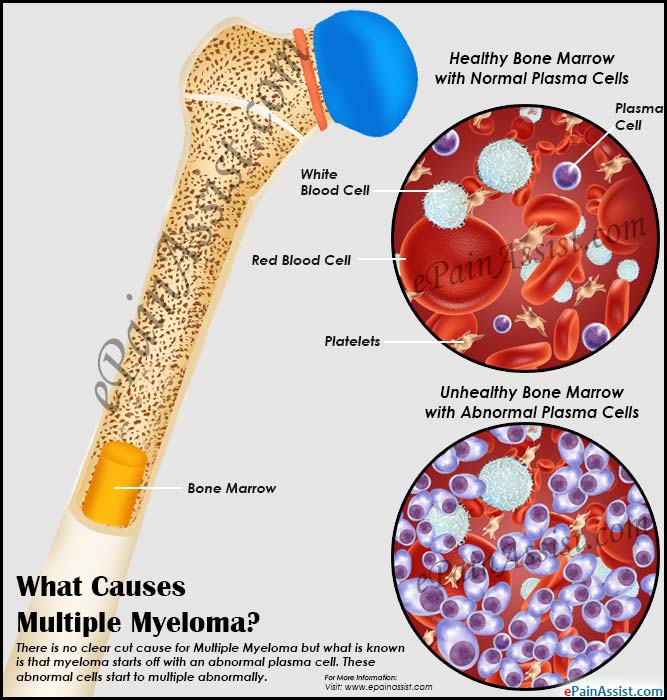
Recently Diagnosed or Relapsed? Stop Looking For a Miracle Cure, and Use Evidence-Based Therapies To Enhance Your Treatment and Prolong Your Remission
Multiple Myeloma an incurable disease, but I have spent the last 25 years in remission using a blend of conventional oncology and evidence-based nutrition, supplementation, and lifestyle therapies from peer-reviewed studies that your oncologist probably hasn't told you about.
Click the orange button to the right to learn more about what you can start doing today.
- You are here:
- Home »
- Blog »
- Multiple Myeloma »
- Myeloma Risk Prediction?
Myeloma Risk Prediction?

The first two paragraphs in the article below explains that myeloma risk prediction is now made possible with the help of artificial intelligence.
In effect, over the past couple of decades, oncology has learned more of everything multiple myeloma- including:
- individual biologic,
- genomic,
- and therapeutic features
Unfortunately, all of the learned MM variables are many and complicated. That challenge is that there are simply too many variables to be considered when giving a prognosis to the newly diagnosed MM patient (NDMM). Too many for an oncologist to make sense of, that is.
But, according to the article below, once artificial intelligence is employed, all the many variables are factored in allowing for an “accurate, individualized risk prediction of treatment outcomes.”
And this is a major step forward in my experience as a long-term myeloma survivor. In my experience all newly diagnosed myeloma patients ask about their prognosis, how long have I got, etc, etc.
Unfortunately, three glaring errors jump out of the essay below- at least in my thinking:
- First, because the FDA and conventional oncology do not study, account for, approve of, etc. evidence-based non-conventional therapies. any myeloma risk prediction model will have a huge hole in it-
- Secondly, as always, conventional oncology measures length-of-life, not quality-of-life. This being the case, again, any myeloma risk prediction model will have another hole in it by not accounting for therapies and QOL.
- Thirdly, the vast majority of board-certified MM specialists adhere to FDA standard-of-care therapy plans. But what about a therapy plan that does not follow FDA SOC guidelines? What might happen to the myeloma risk prediction model then?
The world of non-conventional therapies- from exercise to nutrition to nutritional supplementation such as curcumin, countless studies document the effect that non-conventional therapies have on multiple myeloma.
Quality of life– anyone who has experienced high-dose, aggressive chemotherapies has a window into the short, long-term and late stage side effects that can result from conventional chemotherapy.
The Cure vs. Control Debate in Myeloma- newly diagnosed myeloma patients can’t help but wonder why a board-certified MM specialist who practices a low-dose approach to MM treatment has the best 1, 3 and 5 survival rates of all MM specialists.
I’m a layman so I don’t know how AI works. However I have to believe that what does into, or what is used for the basis information of AI directly affects the answers given by AI. Sort of a high-tech garbage in, garbage out.
But as I said earlier, the article below cites an important step forward for all newly diagnosed myeloma patients. Conventional oncologic therapies will provide a big chunk of each NDMM patient’s therapy plan. Therefore it is important to learn about that therapy plan as fully as possible.
Have you been diagnosed with MM? What stage? What symptoms are you experiencing? If you would like to learn more about both conventional and non-conventional myeloma therapies send me an email- David.PeopleBeatingCancer@gmail.com
Hang in there,
David Emerson
- MM Survivor
- MM Cancer Coach
- Director PeopleBeatingCancer
Artificial Intelligence Individualized Risk Classifier in Multiple Myeloma
“Advancements in comprehending the biogenesis, dependencies, and mutational landscape of multiple myeloma dramatically expanded over the past two decades. This knowledge progress was paralleled by similar surge in novel therapeutics discovery, including the unveiling of new targets and classes of drugs. These advancements presented us, however, with novel challenges to prognosticate the disease with greater precision accounting for its individual biologic, genomic, and therapeutic features…(myeloma risk prediction)
The Takeaway- In the article that accompanies this editorial, Maura et al,1 assisted by artificial intelligence and deep neuronal networks, have introduced the first individualized risk-prediction model for newly diagnosed multiple myeloma (myeloma risk prediction).
This risk-prediction approach is the way forward for the dynamic integration of an ever-widening array of complex genomic, biologic, and soon immunologic features and will permit us to offer patients with myeloma a comprehensive individualized risk prediction adapted to the therapy they will receive.
But it was not until nearly a century after, in 1975, that Durie and Salmon introduced a method for measuring myeloma cell mass that helped prognosticate the diverse disease outcomes.3 The Durie-Salmon (DS) classification was derived by analyzing clinical and biochemical covariates from 71 patients with newly diagnosed multiple myeloma (MM), where through multivariate regression analyses, they demonstrated that myeloma cell mass can be predicted on the basis of
- the extent of bone disease,
- degree of anemia (hemoglobin),
- the presence of hypercalcemia,
- and the quantification of the monoclonal protein in the serum and urine
AI tools such as artificial neural networks (ANNs) can incorporate complex data and discern associations among variable features into adaptable classifiers.26
To this end, they collected clinical, genomic, and therapeutic data from 1933 patients with newly diagnosed myeloma. Accounting for 20 genomic features, including
- chr.1q21 gain or amplifications,
- deletion chr.1p32,
- TP53 loss,
- NSD2 translocations,
- APOBEC mutational signatures,
- and copy number signatures such as chromothripsis,
the authors reclustered previously defined FISH-TC or GEP subgroups into 12 molecular subgroups.
Overall, to our knowledge, the herein-proposed risk classifier by Maura et al1 is the most comprehensive to date, integrating established disease clinical variables with 20 genomics features, providing an accurate, individualized risk prediction of treatment outcomes vastly superior to that afforded by currently adopted risk scores and classifiers.
However, further validation will be required before the full adoption of this new classifier, especially to account for the introduction of monoclonal antibodies and adaptive immune therapies to the disease treatment armamentarium.”


